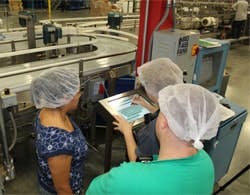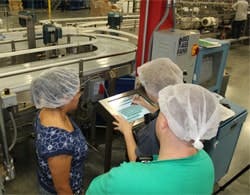Operations management in a bottle
A producer of private-label bottled water, Premium Waters (www.premiumwaters.com) employs more than 700 people across 11 states. The company’s Douglas, Georgia, facility, which was established in 2008, is the newest of the company’s six bottling plants.
The facility produces five types of water, with purified water making up the largest production volume. The plant operates five days a week on four production lines. Volume increases in the summer season when demand for bottled water is higher, and the plant runs up to six days a week during this time.
As with any new facility, the main challenge for the Douglas plant was ramping up productivity as quickly as possible. The Douglas plant produces approximately 75,000 cases/day, with annual production of 10 million to 12 million cases. The plant’s total annual capacity is roughly 15 million cases; however, its average efficiency also was hovering around 50%. For management, this signaled the need to build best practices into the factory that could increase productivity and improve capacity.
Unfortunately, the management team was bogged down in manual paper-based systems, spreadsheets, ad hoc reporting and limited performance monitoring. Decisions were based on gut feel and sometimes on inaccurate information. This made continuous improvement initiatives difficult to introduce and sustain, and it prevented the company from driving real-time action-taking to correct ongoing problems. To address these challenges directly, Premium Waters implemented CDC Factory, a manufacturing operations management system from CDC Software (www.cdcsoftware.com). The packaged solution integrates the functionality of shop floor data capture, packaged metrics such as OEE, constraint management, analytics and scorecards, continuous improvement capabilities and paperless quality management, enabling real-time transparency into performance, down to the line level.
|
View more What Works on PlantServices.com |
CDC performed a three-day profit audit and revealed the Douglas plant had the potential to improve productivity by 10% to 20% in less than five months.
“We quickly recognized that a system such as CDC Factory would help us reach our productivity and capacity improvement goals significantly faster,” says Dave Bauereis, plant manager for Premium Waters. The Douglas team followed the structured CDC implementation program, which focuses on both the technical aspects of a software initiative, as well as the change management aspects of introducing technology enablers on the shop floor. To encourage workforce buy-in, CDC developed a series of awareness meetings and pilot sessions to test the system before going live. Short interval control (SIC) sessions, an integral part of the CDC transformation program, were introduced immediately. The sessions, which take place line-side every two hours, are designed to empower teams to take instant remedial actions and assume immediate responsibility for their respective lines’ performance.
The emphasis on employee buy-in and on behavior change helped to change attitudes in an initially skeptical workplace. There actually was more skepticism among management than on the shop floor. No one on the management team had ever worked with a technology company that said it was going to implement a solution in six weeks and actually delivered on that promise. “CDC Software came through and delivered on time,” says Bauereis. “The system did indeed come out of the box with no costly or lengthy customization required.”
ROI five months ahead of schedule
The Douglas plant began seeing results almost immediately, and, within four months, it had achieved a full 20-point improvement in overall equipment effectiveness (OEE), which resulted in savings of $415,000 during that period. Shop floor teams tackled immediate opportunities first and maintained performance through the SIC review meetings. According to Bauereis, the implementation has exceeded Premium Waters’ performance improvements and ROI expectations. “Our original ROI target was nine months, but the enormous productivity improvements we experienced within weeks of going live yielded a payback within four months,” he says.
The real-time intelligence from CDC Factory enabled the Douglas team to identify line problems that few had realized were a problem, in particular problems with changeovers and minor stoppages that weren’t being recorded. “Thanks to the SIC review meetings and the real-time intelligence, those have been identified and corrected,” says Ric Kovaleski, continuous improvement manager at Premium Waters.
Culturally, the project helped train a largely rural workforce in modern lean techniques while giving them a voice to the senior management team and improving overall ownership and accountability. “The morale on the factory floor has skyrocketed since we began using the new system,” says Tokena Chestnut, operator at the Douglas plant. “You can now look up at the screen and see exactly where we are in terms of budget efficiency. If we’re at 79 and our goal is 80, we push our hardest to get to 80, because we know we can get there. We don’t move; we don’t joke around; we do our thing and try to get that to 80 as fast as we can.”
Quality improvements
Shop floor workers at the Douglas plant for Premium Waters can track productivity and line issues in real time using the software interface.
Premium Waters also implemented CDC Factory’s Quality module alongside the main system. Its capabilities provide improved conformance to both regulatory and customer quality standards, while reducing overhead and eliminating the need for arduous, paper-based systems. The technology provides automated production quality checks and the opportunity for reduced giveaway or scrap through SPC control.
“We’re responsible for more than 500 quality checks per month,” says Sandra Sweat, quality assurance (QA) lead technician at the Douglas Plant. “Having an automated process has been a huge time-saver. If a technician enters information wrong, the system triggers an alert immediately. And when it comes to audits, everything is documented electronically. We no longer have to go through stacks of paper files.”
Since implementing CDC Factory and its Quality module, the Douglas plant has earned the top spot in the company for the least number of consumer complaints. Bauereis adds that, since the implementation of CDC Factory, there’s greater employee awareness about quality. Additionally, he expects that the system will help make the plant’s Safe Quality Food (SQF) certification process easier and will enable the plant to produce quality information for the auditor faster and in a more streamlined fashion.
Mobile performance transparency
From a performance visibility standpoint, the new system made production information much more mobile. When off-site, Bauereis regularly uses his iPad to check the factory’s performance. He and the executive team can see each line’s performance in real time, including any production problems, quality concerns or maintenance problems. This allows Bauereis to address them faster and before they escalate. “I’ve invited plant managers from the other five plants to come down and see what we’re doing,” says Bauereis. “They’re all excited and eager to implement this technology in their own plants. It’s definitely something I would recommend to any manufacturing plant.”
Bar has been raised
Bauereis recently launched an initiative called Project 1200 to ensure the plant maintains its improvement momentum. Project 1200 focuses on one major objective: start delivering 1,200 cases/hr, a level of productivity that would negate the need for overtime. The teams have already made steady progress toward this goal, and some of the areas are close to reaching their objectives already. In fact, Bauereis already is looking beyond the 1,200-case target and pushing Douglas to deliver as close as possible to its theoretical maximum.

